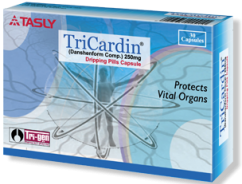Evaluation Of Myocardial Viability With TriCardin
TRIAL CONDUCTED BY: Professor Dr. Shahbaz Ahmed Kureshi. MBBS, MCPS, D. Card, D. Med. Sci, FACC, FACP, FCCP, FPAMS, FASNC, FASIM, FAHA. Diplomate, Certification Board of Nuclear Cardiology (USA)
Head, Department of Cardiology & Nuclear Cardiology
Consultant Nuclear Cardiologist
Senior Consultant Cardiologist,
Federal Government Services Hospital (Polyclinic Islamabad)
In collaboration with Nuclear Oncology Radiation Institute, Islamabad (NORI)
ABSTRACT:
Use of TriCardin/Fu Fang Dan Shen Di Wan, Salvia Miltiorrhiza Root Extract (SMRE) for Assessment of Myocardial Viability
Shahbaz A. Kureshi; Shagufta Zafar Qureshi; Akbar Nawaz Khan; Inam-ul-Haq Khan
Department of Cardiology & Nuclear Cardiology, Federal Government Services Hospital, (Islamabad, Pakistan)
Hibernating myocardium most frequently arises from repetitive ischemia distal to a severe stenosis. The effected area shows depressed resting flow and reduced resting function, functional improvement can occur after coronary revascularization. Salvia Miltiorrhiza Root Extract (SMRE) is the biological name of a cardio tonic drug TriCardin, an eminent herb in the treatment of cardiovascular disorder, which is widely used in China, Japan, Taiwan, Europe, Australia, South Korea, Malaysia, Singapore etc. Several Studies have shown that SMRE has potential effect in attenuating microcirculatory disturbances; along with a definite anti-anginal effect. Keeping in view all the known effects of TriCardin on myocardial circulation, we have used TriCardin to assess myocardial viability.
Aims: The aims in this study are to find out the role of TriCardin in evaluation of hibernating myocardium, and to compare the results of NO3 augmented and TriCardin augmented scans in order to find out the better modality.
Methods: A total of 32 patients (24 male and 8 females), age ranging between 33-72 years (mean age 52.5 years), with history of infarction and ejection fraction less than 30% on echocardiography, were included in this study. All patients were kept fasting in the morning and without medication, especially if they were on NO3 or TriCardin. Each patient underwent 3 studies, (a) resting scan (b) NO3 augmented scan (using standard protocols) (c) TriCardinaugmented scan; in this case two capsules of TriCardin were administered sublingually. Radiotracer was injected after 10 min, and acquisition was done one hour later.
Results: Data interpretation was done by using 17 segments model with 0-4 point scale, i.e. 0= Normal perfusion, 1= Equivocal, 2=Moderate decrease in radiotracer uptake, 3=Severe decrease in radiotracer uptake, 4=absence of detectable radiotracer uptake. Visual analysis of scan results was done by two independent observers and it was found that no improvement in degree of ischemia was noted in N=17 scans, where total number of scans were 32. Improved perfusion were noted in N=15 scans. Out of which N=02 scans showed improvement with NO3 alone, in N=05 scans improvement was noted with both NO3 and TriCardin, and N=08 with TriCardin alone. For statistical inference we applied Chi squared test and considering P value as 0.05; TriCardin was found better than NO3 for assessment of viable myocardium. It was also observed that no fall in systolic blood pressure and many other side effects was noted with TriCardin.
Conclusion: NO3 and TriCardin augmented MPI are two available known invasive diagnostic modalities, for the diagnosis of viable myocardium, out of which TriCardin augmented MPI came out to be the better choice. TriCardin can be utilized even in patients with systolic BP less than 100mm of Hg (which is quite common in patients with damaged hearts), and as TriCardin has a well established role in improving microcirculation, it can be used as long term medical treatment in patients with viable myocardium, who are not fit for surgery.
Recommendations: TriCardin/Fu Fang Dan Shen Di Wan, Salvia Miltiorrhiza Root Extract (SMRE) should be used for diagnostic as well as therapeutic management of chronically ischemic (hibernating/ viable) myocardium.

